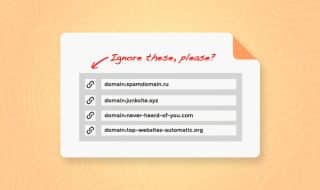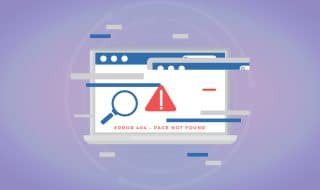How Long Until a Disavow File Takes Effect on Average?

Links are incredibly important for SEO, and likely will be for as long as the concept of search engines exists. Google's foundation is the use of links as votes of confidence to evaluate how valuable and reputable a piece of content is. Everything else layered on top of that is just ways to refine and enhance the accuracy of that evaluation.
The Disavow Links tool is one way Google gives site owners the ability to engage with links pointing at their site, but there's a lot of misinformation, outdated information, and outright misunderstandings about how it works. We're well past the point where we need clarification, so I took it upon myself to dig in.
Why the Disavow Tool Exists
At the very simplest, the search engine algorithm counts the number of links pointing at your site and gives sites with more links a higher ranking.
This obviously would be incredibly easy to manipulate. You could spin up a bunch of domains and slap on microsites, all with links pointing at your main site, and boom: tons of incoming links.
Google has a lot of different ways to get around this kind of manipulation. Pattern recognition, ranking flow, and all sorts of other evaluations are performed to check if the links are valid and viable.
Since some links are clearly manipulative, and others are spammy, Google cuts out their value. In some cases, there are even penalties associated with them.
Sounds reasonable, but there's a problem: if you have a network of microsites and suddenly all the links they send out are negative in value, sure, it's a punishment for your site. But it's also become a weapon.
This is the concept of negative SEO. Instead of using positive links to boost your site, you use negative links to harm your competition.
Google's solution to this, at least for a while, was the disavow tool. If you pull your backlink profile and see a bunch of spammy links, it's very concerning. If Google thinks you built those links yourself (regardless of whether or not you actually did), they could penalize your site for them.

So, you make a list, you hand the list to Google, and you say, "I didn't make these, I don't like these, I would get rid of these if I could."
Obviously, you can't go to a site you don't own and get links removed. All you can do is, from your end, say you don't endorse their existence.
Is the Disavow Tool Necessary in 2026?
Here at the tail end of 2025, I'm looking to the future. Is the disavow tool still relevant?
This is tricky to answer because there are a few different reasons why people use the tool, and most of them are wrong.
Here's the thing: the "penalty" that Google levies against your site because of spam links is not negative SEO. Those links aren't worth negative value.
The penalty, such as it is, is the hit you take when those links are determined to have zero value, instead of a non-zero positive value.
You might not think this is an important distinction, but there's a critical difference between 5-5=0 and 0-5=-5.
Some site owners feel like there's negative SEO in play because they noticed ranking drops and looked to see a bunch of spam links they didn't recognize, and drew the association.
The truth is more likely that a bunch of spammy links built up over time, and at some point, Google did a review pass and nuked some PBNs and other sketchy link domains, and all those links were zeroed out. You aren't penalized for having them, but you do stop benefitting from their existence.
To be clear, I'm not saying negative SEO doesn't exist. But the actual mechanisms of negative SEO these days are a lot more sophisticated and a lot harder to pull off (things like mass reporting for security violations). Basic link bombing is both transparent and obvious, so it's easy for Google to prevent it from working.

So, is the disavow tool still relevant?
Surprisingly, the answer is yes, for two reasons.
The first reason is that not all so-called "negative SEO" is zeroing out link value. Some small percentage of it is triggering a manual action. Google even says as much on their page for the disavow tool:
"In most cases, Google can assess which links to trust without additional guidance, so most sites will not need to use this tool.
You should disavow backlinks only if:
You have a considerable number of spammy, artificial, or low-quality links pointing to your site,
AND
The links have caused a manual action, or likely will cause a manual action, on your site."
In other words, the tool is specifically meant as a way to repair a link-based manual action, and not just a general way to sculpt your incoming link profile.
If you aren't sure if you have a manual action, it's fortunately easy to check.
I said there were two reasons, but Google only gives one. My second one is technically not an endorsed use by Google, and it's entirely optional, but it's a valid option if you want to use it.
Basically, I think it's a valid use of the disavow tool to smooth out potential incoming problems.
If you look at your backlink profile and determine that a bunch of your incoming links are shady, even if they currently benefit you, you might want to cut them off now rather than later, when the drop in value and traffic would be much more abrupt, significant, and devastating to your business.
Google will readily advise you that improper use of the disavow tool can hurt your site, which largely comes down to accidentally disavowing good links. They won't outwardly penalize you for using it. John Mueller has confirmed as much in the past.
How Long Does It Take for the Disavow Tool to Work?
This is where I have some bad news for the people who want to use the disavow tool for rapid response: it's very much not rapid.
Here's what Google says:
"If the upload is successful, it can take a few weeks for Google to incorporate your list into the index as Google re-crawls the web and reprocess the pages that we see."
John Mueller has also clarified this further in some of his chats.
"So in particular with the disavow file, what happens is we take that file into account when we reprocess the links kind of pointing to your website. And this is a process that happens incrementally over a period of time where I would expect it would have an effect over the course of… I don't know… maybe three, four, five, six months… kind of step by step going in that direction."
The disavow tool is not a tool where you upload a list of links and Google cancels their relevance to your site. Rather, it's a tool where Google takes information about links being flagged as potentially spammy, and when they re-crawl those sites, those links are removed from relevance, at Google's discretion.
One of the potential problems here is that Google doesn't spend a lot of time and effort re-crawling spam sites, especially not obvious spam sites. So, if you disavow a link from a site they've already flagged as spam, your specific disavowal of that link is unlikely to take effect right away.
The flip side to that is if Google has already determined the site to be spam, they'll already have made those links valueless, so disavowing them isn't really important. It's all kind of a balance, right?
I have come across an interesting tool, Link Detox Boost. The idea behind it is that you submit your disavow file, wait a couple of days to make sure Google has processed it, and then run the tool. The tool takes your disavowed links and uses some hidden means to force Google to re-index those pages (possibly by using a fetch-as-googlebot command, possibly by visiting it a bunch using Chrome browsers, they refuse to say how it functions), which forces the reprocessing to happen much faster than if you just waited for Google to index it on their own.

Reportedly, this works for manual actions, but not for secondary link algorithms like Penguin used to be. It presumably would work better now that Penguin is a part of the core algorithm rather than a periodic filter like it was.
I can't confirm whether or not the tool works, and it is fairly expensive, so use caution. If you do give it a try, though, let me know how it works!
Can Using the Disavow Tool Hurt Your Site?
Maybe.
I wrote a whole post discussing this over here. The short version is, sometimes you include good links in your disavow file, and Google takes your word for it and removes those links from your link profile, so you lose the value they carried.
Sometimes, legitimate sites have sketchy-looking domain names. Sometimes, bad sites get scared straight and go legit. Sometimes, links might look like they're part of a bad PBN or link scheme, but Google doesn't think so.

Often, using third-party link analysis tools can give you a bad understanding of your links. Some of them are tuned pretty aggressively, under the "better safe than sorry" ethos, but it can do more harm than good if you blindly follow their advice.
While using the disavow tool on its own won't hurt you, getting rid of links that send value to you can, and it can be hard to tell what the truth is when Google's algorithms and the information in your public tools are different.
A Few Clarifying Details on the Disavow Links Tool
There are a few key details about how the disavow tool works that people often get wrong, so I wanted to bring some attention to them.
First of all, disavowing a link won't remove it from your link reports. Disavowing links does not, and never has, removed those links from your backlink reports. The only thing that does that is if Google re-crawls the page and the link is gone.
A lot of people think the disavow tool will remove the links from their backlink profile entirely, but that simply isn't the case. You still need to filter out those bad links in your own reporting, as long as they still exist.
Secondly, the disavow links tool is just a suggestion. It's a suggestion that Google can decide whether or not they want to take.

The fact is, what you consider bad and what Google considers bad may be different. Beyond that, though, a lot of times Google will have already flagged the domains you're flagged, so adding your disavow to it isn't really going to do anything, positive or negative.
I've seen some people disavow links, not see their rankings rise, and conclude that Google is ignoring their file. The truth is more likely that Google has already flagged those URLs, and your disavow file is just redundant.
Removing your disavow file isn't necessarily a complete reversal. When you remove links from your disavow file or remove the file completely, Google will feel free to re-index and re-evaluate those links. But a lot of those links might still be flagged as spam for other reasons, and Google isn't going to make them count anyway. Similarly, many of those links might have disappeared over time.
Some of the links will return, and others won't.
The only way that removing a disavow file can hurt your site is if you had a whole PBN or set of PBNs pointing at your site, and those PBNs haven't been entirely nuked by Google, but they have still decided to issue a manual action to sites they know are using them. It's a pretty niche set of circumstances, but if you use the disavow tool to fix a manual action and then remove the file later, the manual action could return.
Should You Bother Using the Disavow Links Tool?
At this point, I think the disavow tool is on its way out.
If your site has been hit by a manual action due to bad links, then yes, give the disavow links tool a try. I don't know that it will help very quickly, since it usually takes at least a month for any significant number of the bad links to be re-indexed, but that's the stated purpose of the tool.
It's also possible that Google will pay extra attention to recipients of manual actions and can specially re-crawl those links when the disavow file is submitted. To be clear, though, that's entirely conjecture on my part, so don't take that as gospel.

For all the other link-sculpting purposes, I don't know that the disavow tool is all that useful. Google has a thousand different ways to tell if a link is spammy, and they're quite active at flagging those sites as valueless, zeroing them out so they can't be used positively or negatively.
At the same time, there's a constant churning undercurrent of sites being compromised and weaponized, and it can be important to keep on top of those kinds of attacks.
I personally think that Google used the disavow links tool as a way to harvest a lot of data to use to look for PBNs, to identify subtle spam signals, and to train their machine learning. I think they've reached a point where it's no longer important to gather that data, and they keep the tool around specifically to address manual actions in a limited capacity.
I wouldn't be surprised if it disappears in the next few years. Even John Mueller mentioned that he wouldn't be surprised if they removed it soon, and Bing has removed their equivalent already. Will 2026 be the year it goes away? I guess we'll find out.










Comments